(A) : When a mixer in a kitchen is switched on the sound from a radio in the kitchen gets nosiy. (R) : The sparking inside the mixer generates electromagnetic waves
Both 'A' and 'R' are true and 'R' is the correct explanation of 'A'.
Both 'A' and ’R' are true and 'R' is not the correct explanation of 'A
A' is true and 'R' is false
'A' is false and R' is true
The correct Answer is:A
To solve the question, we need to analyze both the assertion (A) and the reason (R) provided.
1. Understanding the Assertion (A):
- The assertion states that when a mixer in a kitchen is switched on, the sound from a radio in the kitchen becomes noisy. This indicates that the operation of the mixer interferes with the radio's sound quality.
2. Understanding the Reason (R):
- The reason given is that the sparking inside the mixer generates electromagnetic waves. This suggests that the mixer produces some form of electromagnetic interference (EMI) when it operates.
3. Connecting A and R:
- When electrical appliances like mixers are turned on, they can create sparks due to the switching of electrical currents. These sparks can emit electromagnetic waves, which can interfere with nearby electronic devices, such as radios. This interference can cause the radio to produce a noisy sound.
4. Evaluating the Truth of A and R:
- Both the assertion and the reason are true statements. The assertion accurately describes the phenomenon of noise in the radio when the mixer is switched on, and the reason correctly explains that this noise is due to electromagnetic waves generated by the sparking in the mixer.
5. Conclusion:
- Since both the assertion and the reason are true, and the reason provides a correct explanation for the assertion, we conclude that the answer to the question is that both A and R are true, and R is the correct explanation for A.
Final Answer:
Both the assertion (A) and the reason (R) are true, and R is the correct explanation for A.
---
- The assertion states that when a mixer in a kitchen is switched on, the sound from a radio in the kitchen becomes noisy. This indicates that the operation of the mixer interferes with the radio's sound quality.
- The reason given is that the sparking inside the mixer generates electromagnetic waves. This suggests that the mixer produces some form of electromagnetic interference (EMI) when it operates.
- When electrical appliances like mixers are turned on, they can create sparks due to the switching of electrical currents. These sparks can emit electromagnetic waves, which can interfere with nearby electronic devices, such as radios. This interference can cause the radio to produce a noisy sound.
- Both the assertion and the reason are true statements. The assertion accurately describes the phenomenon of noise in the radio when the mixer is switched on, and the reason correctly explains that this noise is due to electromagnetic waves generated by the sparking in the mixer.
- Since both the assertion and the reason are true, and the reason provides a correct explanation for the assertion, we conclude that the answer to the question is that both A and R are true, and R is the correct explanation for A.
Both the assertion (A) and the reason (R) are true, and R is the correct explanation for A.
Topper's Solved these Questions
- ELECTROMAGNETIC WAVESBOOK - AAKASH SERIESCHAPTER - ELECTROMAGNETIC WAVESEXERCISE - EXERCISE -II
22 Videos
- ELECTROMAGNETIC WAVESBOOK - AAKASH SERIESCHAPTER - ELECTROMAGNETIC WAVESEXERCISE - EXERCISE -IA
47 Videos
- ELECTROMAGNETIC INDUCTIONBOOK - AAKASH SERIESCHAPTER - ELECTROMAGNETIC INDUCTIONEXERCISE - Additional Exercise
11 Videos
- ELECTROMAGNETICSBOOK - AAKASH SERIESCHAPTER - ELECTROMAGNETICSEXERCISE - ADDITIONAL EXERCISE
13 Videos
Similar Questions
VC is the ideal voltmeter in the figure. Resistance of the resistor shown is R. Initially the switch is in position 2 when charging of the capacitor starts. Initially the capacitor was uncharged. The switch in circuit shifts automatically from 2 to 1 when VC>2V/3 and goes back to 2 from 1 when VC<V/3. The ideal voltmeter reads voltage across capacitor as plotted. What is the period T of the wave from in terms of R and C ?
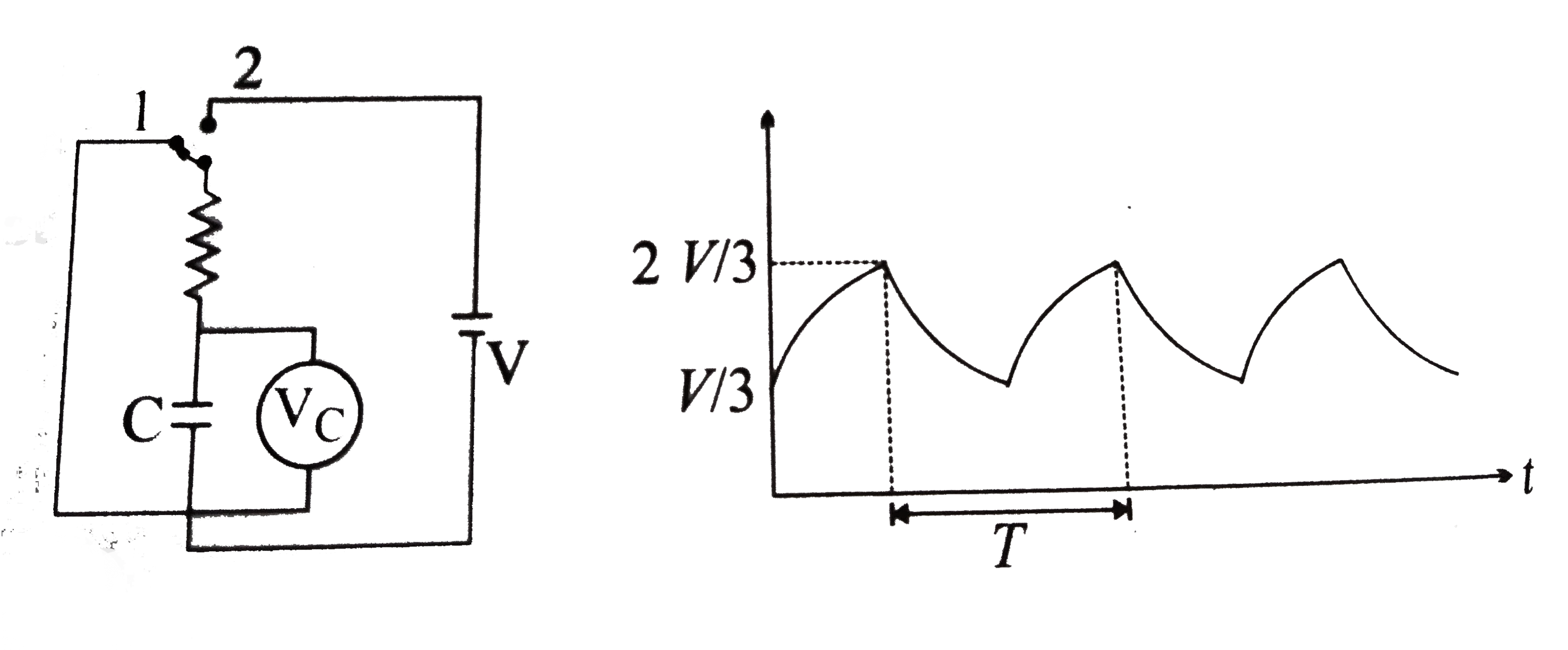 ,
,
View SolutionMost materials have the refractive index, n>1. So, when a light ray from air enters a naturally occuring material, then by Snell's law, sinθ1sinθ2=n1n2, it is understood that the refracted ray bends towards the normal. But it never emerges on the same side of the normal as the incident ray. According to electromagnetism, the refractive index of the medium is given by the relation, n=(c/v)=±√εr,μr, where c is the speed of the electromagnetic waves in vacuum, v its speed in the medium, εr and μr are negative, one must choose the negative root of n. Such negative refractive index materials can now be artifically prepared and are called meta-materials. They exhibit significantly different optical behaviour, without violating any physical laws. Since n is negative, it results in a change in the direction of propagation of the refracted light. However, similar to normal materials, the frequency of light remains unchanged upon refraction even in meta-materials.
Answer the following questions :
For light incident from air on a meta-material, the appropriate ray diagram is
View SolutionMost materials have the refractive index, n>1. So, when a light ray from air enters a naturally occuring material, then by Snell's law, sinθ1sinθ2=n1n2, it is understood that the refracted ray bends towards the normal. But it never emerges on the same side of the normal as the incident ray. According to electromagnetism, the refractive index of the medium is given by the relation, n=(c/v)=±√εr,μr, where c is the speed of the electromagnetic waves in vacuum, v its speed in the medium, εr and μr are negative, one must choose the negative root of n. Such negative refractive index materials can now be artifically prepared and are called meta-materials. They exhibit significantly different optical behaviour, without violating any physical laws. Since n is negative, it results in a change in the direction of propagation of the refracted light. However, similar to normal materials, the frequency of light remains unchanged upon refraction even in meta-materials.
Answer the following questions :
Choose the correct statement.
View SolutionAn indian submarine is moving in the Arabian sea with constant velocity. To detect enemy it sends out sonar waves which travel with velocity 1050ms in water. Initially the waves are getting reflected from a fixed island and the reflected waves are coming back to submarine. The frequency of reflected waves are detected by the submarine and found to be 10% greater than the sent waves.
Now an enemy ship comes in front, due to which the frequency of reflected waves detected by submarine becomes 21% greater than the sent waves.
Q. Bulk modulus of sea water should be approximately (ρ=water=1000kgm3)
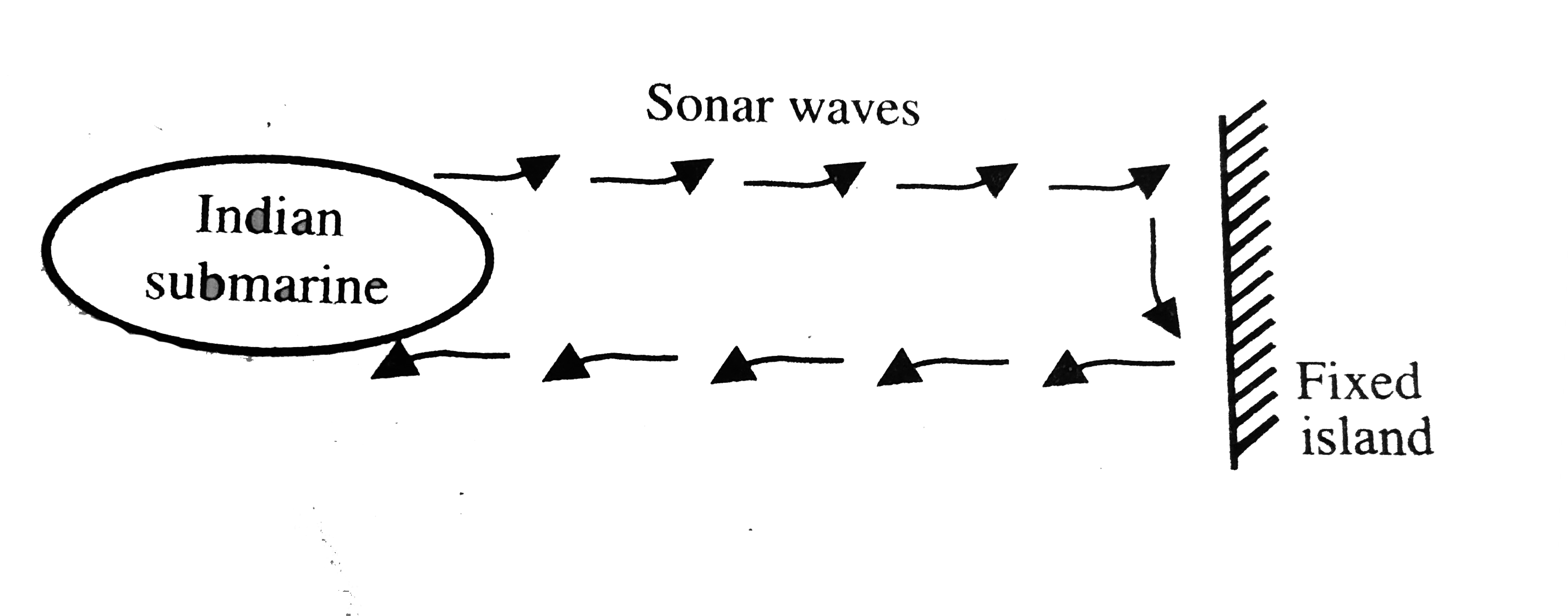
View Solution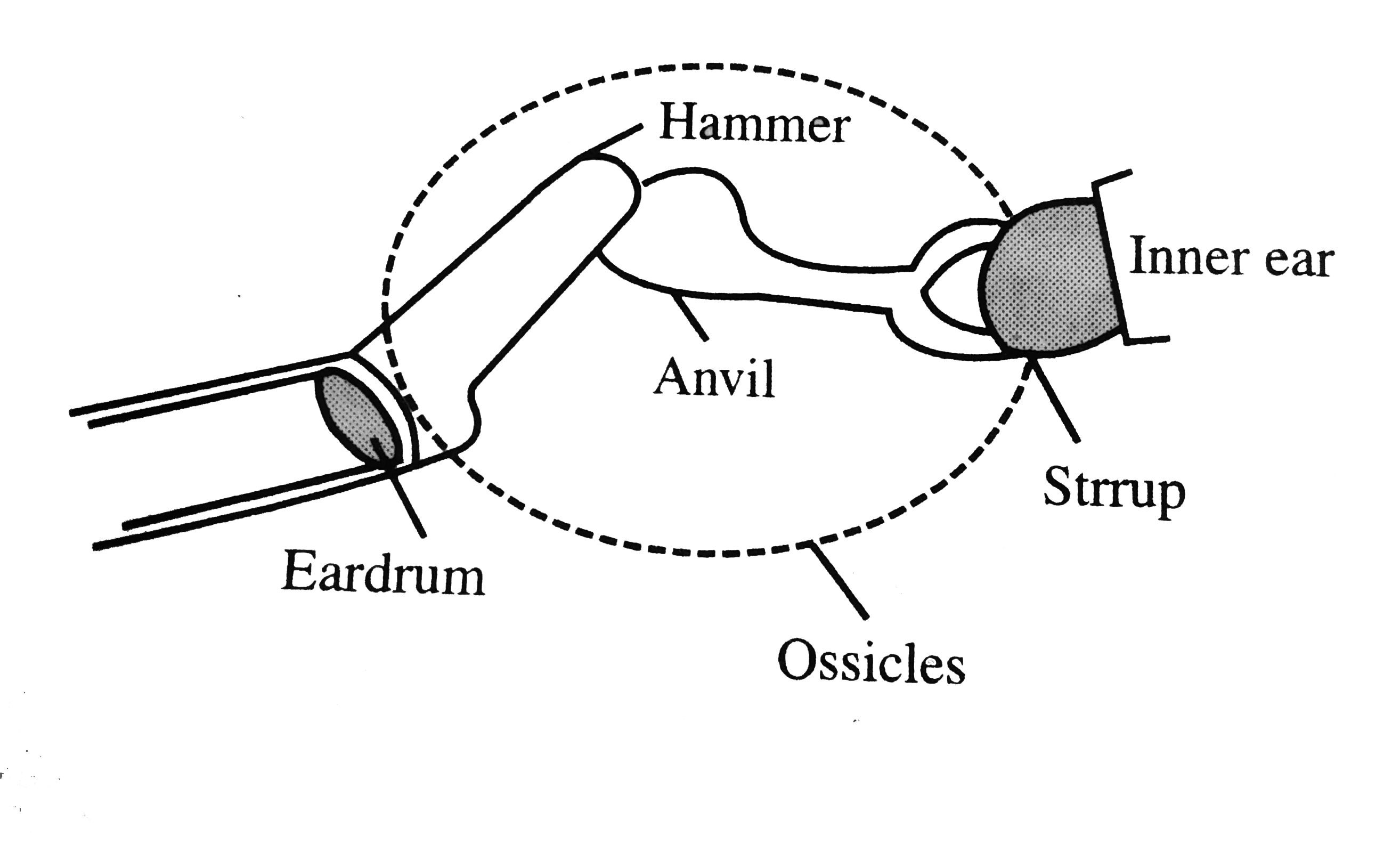
When a sound wave enters the ear, it sets the eardrum into oscillation, which in turn causes oscillation of 3 tiny bones in the middle ear called ossicles. This oscillation is finally transmitted to the fluid filled in inner portion of the ear termed as inner ear, the motion of the fluid disturbs hair cells within the inner ear which transmit nerve impulses to the brain with the information that a sound is present. The theree bones present in the middle ear are named as hammer, anvil and stirrup. Out of these the stirrup is the smallest one and this only connects the middle ear to inner ear as shown in the figure below. The area of stirrup and its extent of connection with the inner ear limits the sensitivity of the human ear consider a person's ear whose moving part of the eardrum has an area of about 50mm2 and the area of stirrup is about 5mm2. The mass of ossicles is negligible. As a result, force exerted by sound wave in air on eardum and ossicles is same as the force exerted by ossicles on the inner ear. Consider a sound wave having maximum pressure fluctuation of 4×10−2Pa from its normal equilibrium pressure value which is equal to 105Pa. Frequency of sound wave in air is 332ms. Velocity of sound wave in fluid (present in inner ear) is 1500ms. Bulk modulus of air is 1.42×105Pa. Bulk modulus of fluid is 2.18×109Pa.
Q. This person (without hearing aid machine) is sitting inside a busy restaurant where average sound intensity is 3.2×10−5Wm2. How much energy in the form of sound is taken up by the person in his meal time of 1 h?
View SolutionComponents of loudspeaker :
A loudspeaker consists of permanent magnets, basket, voice cails, flexible supension & rigid speaker cone as shown in figure.
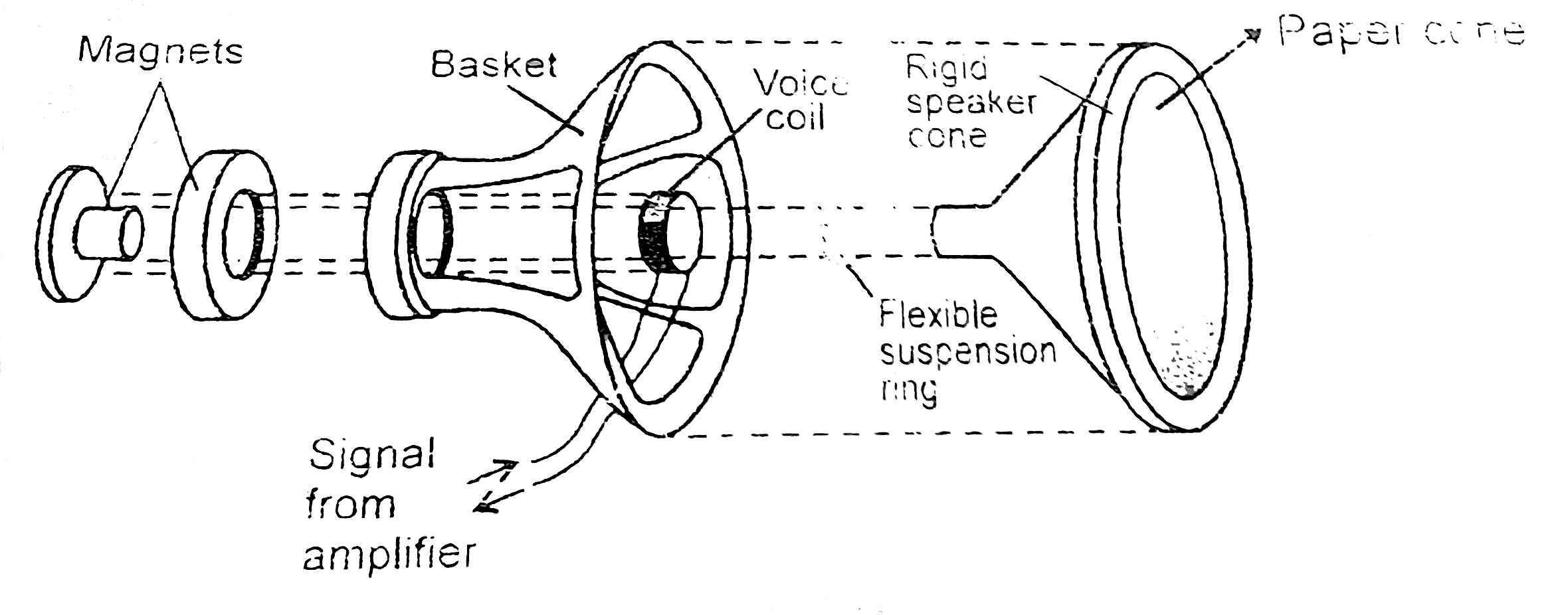
Loudspeaker principle
A light voice coil is mounted so that it can move freely inside the magnetic field of a strong permanent magnet. the paper cone is attached to the voice coil and attached with a flexble mounting to the outer ring of the support .Because there is a definite equilibrium position for the speaker cone and there is elasticity of the mounting structure, there is inevitably a free cone resonant frequency like of a mass on a spring. The frequency can be determined by adjusting the mass and stiffness of the cone and voice coil
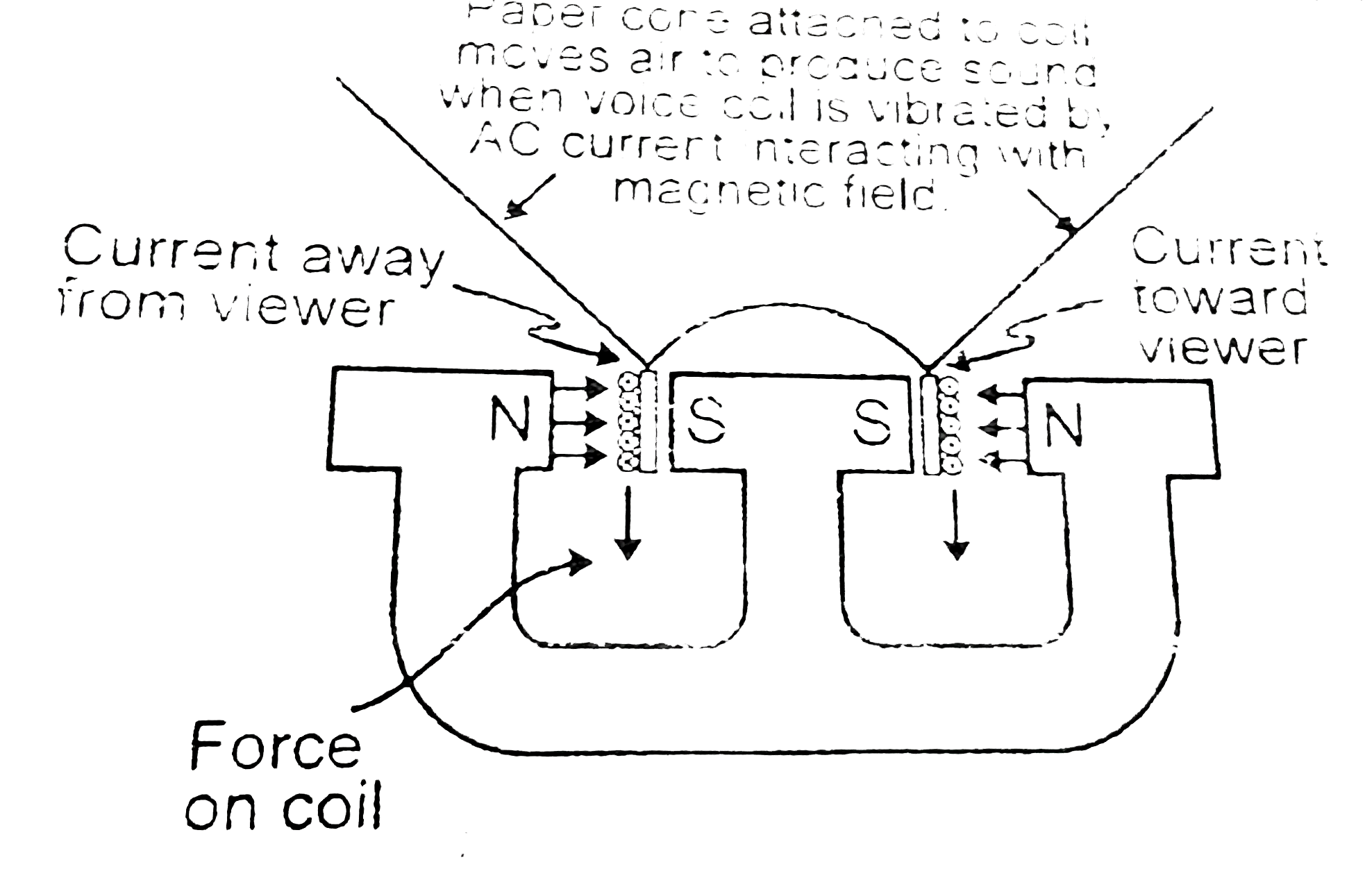
Working :
The ratio drives a rapidly changing current through the coil. The current follows that vibrations of speech and the electromagnetic force follows the current changes, pushing the paper cone. Finally the air in front of the loudspeaker is set into vibration following the cone's motion, and sound waves are transmitted to the listener
With reference to the figure of Q.& when the current in the coil is given by I=Iccos(2000πt) where t is in seconds. the coil will experience magnetic force in the positive y-direction in the time intervals of : (Take the initial direction of cirrent shown in figure to be positive)
View SolutionComponents of loudspeaker :
A loudspeaker consists of permanent magnets, basket, voice cails, flexible supension & rigid speaker cone as shown in figure.
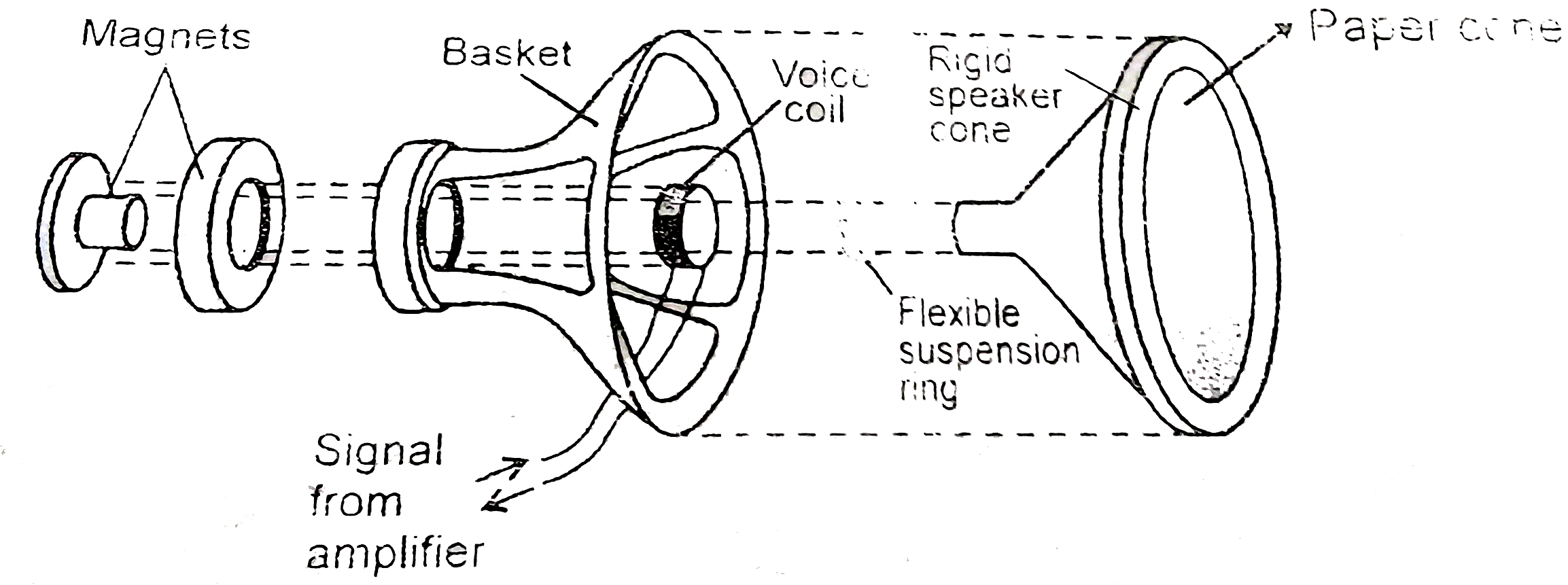
Loudspeaker principle
A light voice coil is mounted so that it can move freely inside the magnetic field of a strong permanent magnet. the paper cone is attached to the voice coil and attached with a flexble mounting to the outer ring of the support .Because there is a definite equilibrium position for the speaker cone and there is elasticity of the mounting structure, there is inevitably a free cone resonant frequency like of a mass on a spring. The frequency can be determined by adjusting the mass and stiffness of the cone and voice coil
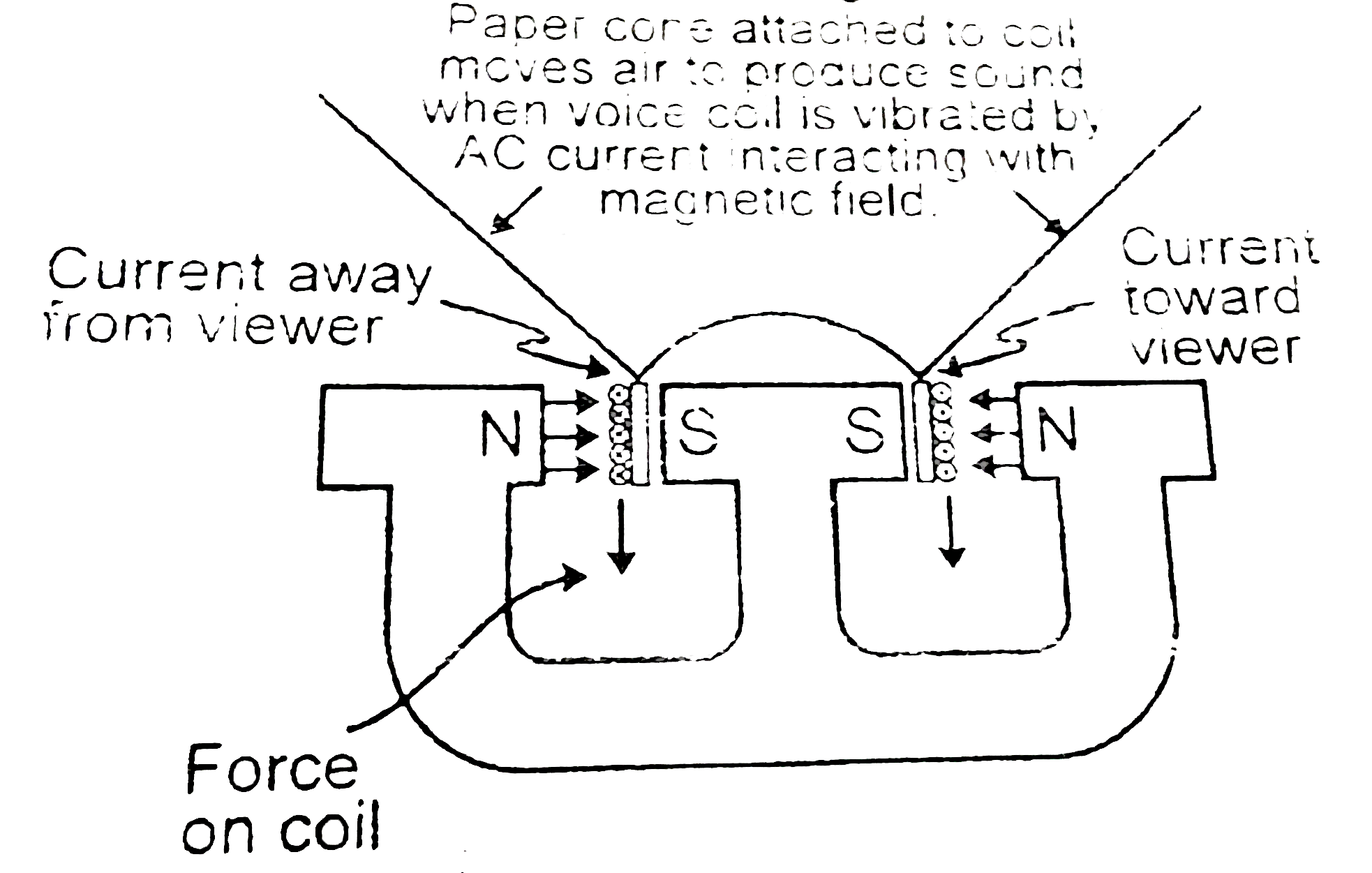
Working :
The ratio drives a rapidly changing current through the coil. The current follows that vibrations of speech and the electromagnetic force follows the current changes, pushing the paper cone. Finally the air in front of the loudspeaker is set into vibration following the cone's motion, and sound waves are transmitted to the listener
If the voice coil is wound loosely and there is an approachable gap between two consecutive turns. When the current is passed through coil :
View Solution(A) : The wave length of sound waves increases when they are refracted from air into water
(R): Velocity of sound is greater in water than in air
View SolutionGiven below are some of the process which takes place in our ear when we are exposed to any sound. Arrange these in the correct order of sequence.
(a)The eardrum vibrates the transmits the sound wave to the ear ossicles.
(b) Vibration travel from oval window to the fluid of cochlea.
(c) Ripples in the basilar membrane band the hair cell against the tectorial membrane
(d) Generation of waves in the lymphs.
(e ) sound waves are collected
by the pinna.
(f) generation of nerve impulse and transmission through auditory nerves to the brain
View SolutionEarthquakes generate sound waves inside the earth. In case of the earth, both transverse (S) and longitudinal (P) waves can propagate. Typically, the speed of S waves is about 4.5 km s−1 and that of P waves is 8.0 km s−1. A seismograph records both P and S waves from an earthquake. this difference helps us to find the distanec of the point of origin of the earthquake. this point is called the epicenter.
Q. The reading of the time lag between the arrival of S and P waves gives us the distance of the epicenter from the location of a seismograph. the readings of what minimum number of seismographs would be necessary to pinpoint the location of an epicenter?
View Solution
